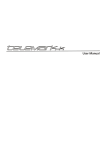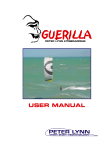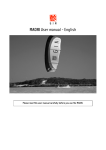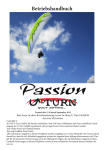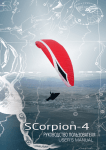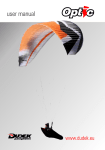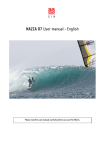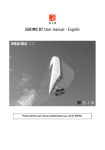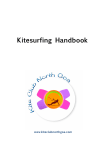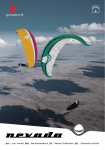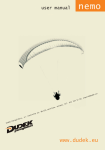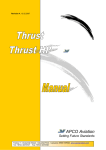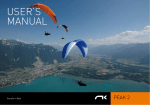Download User manual
Transcript
OMEGA 8 User manual Edition 12-2010 Contents Thank you for flying ADVANCE ....................................................... 4 About ADVANCE . ............................................................................ 5 The OMEGA 8................................................................................... 6 Inspired by Success .................................................................... 6 Outstanding features . .................................................................. 6 Other important details................................................................. 7 Pilot requirements . .......................................................................... 9 General information on paragliding.............................................. 9 Using the paraglider....................................................................... 10 Delivery....................................................................................... 10 Basic settings . ........................................................................... 10 Adjusting the brake lines . .......................................................... 10 Adjusting the speed system........................................................ 10 Speed-Performance-Indicator (SPI)........................................... 12 Suitable harnesses . ................................................................... 13 Weight range .............................................................................. 14 Flight characteristics ..................................................................... 15 Launch......................................................................................... 15 Normal flight ............................................................................... 15 Turns . ......................................................................................... 16 Accelerated flight........................................................................ 16 Collapses ....................................................................................17 Rapid descent ............................................................................ 18 Stalling . ...................................................................................... 20 Landing ...................................................................................... 21 Flying with a wet glider . ............................................................. 21 Winching .................................................................................... 22 Aerobatics................................................................................... 22 Paramotoring .............................................................................. 22 Maintenance, repairs and service intervals .................................. 24 Packing . ..................................................................................... 24 Care and maintenance . ............................................................. 24 Lines ........................................................................................... 24 Check ......................................................................................... 25 Repairs........................................................................................ 25 Disposal ..................................................................................... 25 Technical details............................................................................. 26 Materials used............................................................................. 27 Certification................................................................................. 28 Service............................................................................................ 30 ADVANCE Service Centres......................................................... 30 The ADVANCE website............................................................... 30 Warranty ..................................................................................... 30 Parts . ............................................................................................. 32 Lineplan ......................................................................................... 33 Risers ............................................................................................. 34 Bowline knot................................................................................... 34 3 Thank you for flying ADVANCE Congratulations on your choice of an OMEGA 8 - a quality product from ADVANCE. We are sure that you will spend many rewarding hours in the air with it. The user manual is an important part of the glider. Here you will find instructions and important information about safety, care of the glider and maintenance, and that’s why we recommend that you read this booklet carefully before your first flight. The latest version of this manual as well as further updated information can be found at www.advance.ch. Any new safety-related information will also be published on the website. If you have any further questions or problems please contact your dealer or get in touch directly with ADVANCE. We wish you a lot of enjoyment from your OMEGA 8, and always «happy landings». Team ADVANCE 4 About ADVANCE ADVANCE, based in Switzerland, is one of the world’s leading paraglider manufacturers. Since it was founded in 1988, the company has consistently pursued its own directions and concepts, both in development and production. The results are quality products with distinctive characteristics. port, and has built up a worldwide service network for this purpose. An on-going interaction with its customers brings in a steady flow of new knowledge that finds its way into ADVANCE products, thus completing the «Circle of Service». At the heart of the ADVANCE brand is a team of specialists who share the passion of the customers who place their trust in the company’s products. With their thorough understanding of flying they contribute their valuable personal experience and dedication to the working processes. For many years ADVANCE has drawn on the competition scene for its technical expertise. Its small team of test and competition pilots regularly notches up remarkable sporting successes with ADVANCE prototypes, winning numerous important international titles. Total control of the production process and supervision of the working practices at the ADVANCE factory in Vietnam ensure a high standard of workmanship. Long term relationships with fabric and line manufacturers means that ADVANCE knowledge and expertise also finds its way directly into the development of new materials. ADVANCE attaches great importance to after-sales customer sup5 The OMEGA 8 ADVANCE OMEGA 8 – Inspired by Success With the OMEGA 8 you’ll find yourself at the top of the XC league! The OMEGA 8 is the highest performance glider in the serial class. It has yet again set a new benchmark, just like the OMEGA series gliders before it. The new ADVANCE flagship glider embodies tradition and progress at the same time. Its handling and design are unmistakable. Outstanding features Fascinating flying feeling stability, balanced pitch and a speed system that is fine-tuned to the wing’s profile give the competitive pilot the edge. Built from success The OMEGA 8 builds on the proven three liner concept of the 2009 ADVANCE World Championship winning glider and the X-Alps winning prototype. The OMEGA 8 is also one of the lightest performance wings with a new construction, carefully selected materials and nylon wire battens at the leading edge. All these new technologies have been rigorously tested and refined to perfection. With distinctive, direct handling and incredible performance the OMEGA 8 has plenty of allure. Two of its outstanding characteristics are its smooth and efficient speed system and the incredibly good stability at speed. The twist on the airfoil’s angle of attack is optimized for stability. Sensitive feedback from the wing tips gives the pilot complete control even in the roughest air. Performance across the range With a glide ratio of 10.6 and a useable top speed of 59 km/h, the OMEGA 8 is by far the best performer in its class. And the OMEGA 8 comes into its own in accelerated flight through turbulent air. The solid 6 Other important details Efficient and smooth 2-phase speed system with SPI FASCINATING POWERFUL Thanks to its 3 line levels and the choice of profile the OMEGA 8 can be very efficiently accelerated with little effort. In addition the OMEGA 8 has a variable ratio speed system. This means that the speed bar travel and pressure can be changed to suit the user’s anatomy: smooth, 3:1 ratio when the legs are bent, and efficient, more direct 2:1 with outstretched legs. During accelerated flight the Speed-Performance-Indicator (SPI) always shows the ideal against the currently selected accelerate setting. Specially coated lines The OMEGA 8’s uncovered lines have a high resistance to UV radiation and physical abrasion thanks to their compact braid and an additional coating of the individual line fibres. The loops at the line junctions are reinforced, which results in lower contact surface pressure. A well-tried Dyneema/Aramid mix has been used for the brake lines to ensure minimum stretching. REFINED 7 ADVANCE Standards ADVANCE pays a lot of attention to small details. Sewn-in tension straps and Mylar reinforcements improve the wing’s stability, and the distinctive winglets reduce induced drag (vortex-effect). The Smart Sail System aligns the material at the leading edge in the best direction to match the loads in this area, and a strong, specially impregnated fabric is used here to improve the life of the wing. Velcro closures at the wingtips make it easy to remove debris like sand and snow from the glider. Like all ADVANCE models the OMEGA 8 has swivels on the brake lines and different sized brake handles with magnets, depending on the glider size. 8 Pilot requirements The OMEGA 8 is a purebred high-performance paraglider that should only be flown by highly experienced, performance-oriented longdistance or competition pilots. In order to be able to fully master an OMEGA 8, a pilot must already possess experience of high-performance gliders in different weather conditions. A regular flyer with these skills and with lots of experience of active flying through turbulence will be able to safely exploit the paraglider’s huge performance potential and cover long distances in a controlled and relaxed manner. ufacturer nor the seller of a paraglider can guarantee or be held responsible for the pilot’s safety. General information on paragliding Flying a paraglider calls for appropriate training and a sound knowledge of the subject, as well as, of course, the necessary insurance cover and licence. A pilot must be able to correctly assess the weather conditions before taking off. His or her capabilities must be adequate for the actual paraglider. Wearing an adequate helmet, suitable boots and clothing, and carrying an emergency parachute are essential. Before every flight all items of equipment should be checked for damage and airworthiness. A proper pre-takeoff check must also be carried out. Every pilot bears sole responsibility for all risks including injury or even death when carrying out paraglider sports. Neither the man9 Using the paraglider Delivery Adjusting the brake lines Before delivery every ADVANCE paraglider has to be flown by the dealer and checked for correct settings and trim. When this has been done the dealer enters the date of the first flight on the label attached to a centre rib. This entry, together with a completed warranty form, will ensure that defects in the product attributable to manufacturing faults are covered by the ADVANCE warranty. See Warranty in the section «Service». The length of the brake lines is set at the factory so that the trailing edge is not braked (is crease-free) when brakes are fully released in fully accelerated flight. This setting should be kept as a matter of principle. The OMEGA 8 comes with a backpack, an inner bag, a compression strap, a repair kit, speed bar with lines, a mini windsock in the canopy colours and a booklet called ‘Getting started’. If the length of the brake lines has to be readjusted there must be 8 cm of slack (free travel) between the brakes free position and the first effect of brake on the trailing edge in un-accelerated flight. We recommend that the brake handles are secured with a bowline knot. Look at the attached illustration, page 35. Adjusting the speed system Basic settings The basic OMEGA 8 set-up at delivery is the original trim setting that the ADVANCE test team have found to be best; and the glider was certified in this condition. Any personal alteration or modification to the paraglider - for example, changing the line lengths or fitting different risers or quick links by the owner - will result in invalidation of the certification. See section «Certification». We recommend that the OMEGA 8’s speed system is correctly adjusted before the first flight. This should include a check to ensure that the whole acceleration range can be used. The OMEGA 8’s riser system should be connected to the harness speed lines by means of Brummel hooks 1 . After initial adjustment of the speed bar for leg length and harness, fine adjustment is carried out by altering the 2-phase speed system on the risers: by moving the knots which locate the gear change balls 10 (see ball 2 in the illustration) the speed bar travel and load can be adjusted. Example: If the knots are moved downwards the change from 3:1 to 2:1 occurs earlier, then raising the loading but shortening the total travel. Conversely, moving the knots upwards delays the gear change, eases and lengthens the total travel of the speed bar. 1 Optimum adjustment of the 2-phase system enables a smooth triple transfer with bent legs and an efficient double transfer with outstretched legs. The OMEGA 8 speed system is arranged so that the profile shape is fully retained over the angle-of-attack range of the speed system. This keeps the good qualities of the profile at high speeds. The separation of the outer C-risers allows the acceleration to be fine-tuned, to increase the stability of the wing tip in accelerated flight. 2 Caution: The speed system is correctly adjusted when you can apply the whole accelerate travel of the glider. Be careful not to adjust the speed lines so short that the wing would be accelerated in flight all the time. 11 Speed Performance Indicator (SPI) As a high-end long-distance paraglider, the OMEGA 8 is designed for accelerated flight in turbulent air. Because today’s accelerated flying plays a decisive role in performance-hungry paragliding, a high average speed is the critical factor for success on long flights. It calls for continual adjustment of speed depending on the prevailing headwind, sink rate and anticipated climb in order to obtain both best glide and also the shortest flight time to cloud base. This is why the SPI is of particular importance to the OMEGA 8. Based on careful calculations from the polar curve five positions with values for prevailing headwind , sink rate (both values measured in un-accelerated flight) and the expected next rate of climb are provided on the back of the D-risers. Lining up the sliding red speed system indicator on the SPI scale gives a precise setting for best performance for the air you are flying through. The positions specified on the SPI only apply to any one of the three listed values per position, considered by itself. The principle of the SPI is based on the simple and expanded McCready speed-to-fly theory. 12 Example: OMEGA 8 25 Example: the first speed bar position applies to either 18.5 km/h headwind or 1.9 m/s descent rate (Vario) or an expected (Vario) average next climb rate of 0.9 m/s (see I in the illustration). I If headwind, descent rate and expected climb are considered in combination, the correct speed bar position is more than cumulative because the polar curve is not a straight line. Example: If the headwind is 18.5 km/h and the sink rate is 1.9 m/s, then your speed bar setting should be somewhat faster than the second position on the SPI (see II in the illustration). If an expected climb of 0.9 m/s is considered as well, you should be pushing well past position three on the SPI (see III in the illustration). II III 13 Suitable harnesses The ADVANCE OMEGA 8 is certified for harnesses in group GH (without rigid cross-bracing - see the «Certification» section). The suspension points of the chosen harness should ideally have a distance of 40 to 45 cm as well as a height of 40 to 46 cm. The OMEGA 8 is neither suitable nor approved for harnesses in the GX group (with active cross-bracing). The use of this type of harness may have a detrimental effect on the handling and extreme flight characteristics. Flying at the lower or upper limits of the weight range can affect the flying characteristics of the wing, without, however, compromising your safety. The OMEGA 8’s performance remains the same whether flying in its lower or upper weight region. The ADVANCE OMEGA 8 was specially trimmed for use with a streamlined harness. For this reason we recommend a harness with speedbag in order to get the best out of the OMEGA 8’s great performance. The ADVANCE IMPRESS harness is particularly suitable since the OMEGA 8 was designed and tested with it in mind. Weight range The weight ranges for the different wing sizes are listed in the «Technical Data» section. The figures given there refer to total take-off weight. This includes the pilot’s body weight including clothing, as well as the weight of all the equipment (paraglider, harness, instruments, etc. – everything that’s going to fly). 14 Flight characteristics We recommend that first flights with the new paraglider be undertaken in calm conditions at a familiar place. A few pull-ups on gentle terrain will increase your confidence in the OMEGA 8’s handling, from the very beginning. Launch Thanks to its easy-rising profile the OMEGA 8 is astonishingly easy to take off - for a paraglider of its class. Nevertheless, the high aspect ratio means that it is best to lay out the paraglider in a slight curve, so that the canopy fills evenly from the centre. Reverse launch Reverse launch is particularly recommended in stronger breezes, but it is also easy in light wind. On account of the long lines the pilot should walk or run towards the OMEGA 8 as necessary while pulling up, so as to control the tug and rising rate of the paraglider, and so prevent any tendency for it to overshoot the overhead position. During a reverse launch, corrections during pull up should ideally only be carried out by pilot movement under the wing. Stabilising the wing in the overhead position, turning and taking off will then be easy. Normal flight Forward launch Despite its long lines the OMEGA 8 needs only a light impulse for pulling up. Lead the glider up with pronounced forward leaning, but without too much pull on the A-risers, until the wing has risen cleanly above you. Any corrections during the inflation phase should only be made by pilot movement under the glider - without using brake. After corrections and a visual check, a few quick steps with a pronounced forward lean are all that are required to launch, even in light wind. In calm air, the OMEGA 8 best glide is achieved with zero brake. Light braking brings the glider to its speed for minimum sink rate. In headwinds, sinking air and an expected climb in the next thermal cross country performance is significantly improved by appropriate use of the accelerator. The SPI will help you here. See also section «Speed Performance Indicator (SPI)». An active flying technique is generally recommended in turbulent air. Info: Make sure that you always take note of your weight and the type of harness for comparison flights. The exceptional performance of the OMEGA 8 becomes evident above all in 15 accelerated condition into a headwind and – because of its well-behaved pitching behaviour – in turbulent air. Turns The OMEGA 8 has short and soft, but also very precise braking and steering travel. It responds very directly and progressively to increasing brake inputs. Control of the paraglider is easily assisted by active weight shifting. The OMEGA 8 holds your chosen turn radius with a steady steering application – without needing large corrections from you. You can always increase or reduce your angle of bank by pressure on the brake lines. The OMEGA 8 makes a very agreeable companion in thermals. You do not have to correct for large pitching movements, and this improves your climbing behaviour – and therefore your performance – significantly. When thermalling, choose the desired angle of bank and corresponding radius, and try to let the glider turn steadily in this attitude. Outside brake should be used to steady the wing tip and, in particular, control the rate of turn. A harness specifically designed to match the flying characteristics of the OMEGA 8 helps you to initialise and stabilise turns of this type, which should be as even as possible. See also section «Suitable harnesses». Accelerated flight The OMEGA 8 has a low drag line system and wing design, a high aspect ratio and exceptionally well-behaved pitching qualities in turbulent air. These all help to give it a very good glide performance with only moderately increasing sink rates, even in accelerated flight. In addition the 3 line levels and the choice of profile mean that the OMEGA 8 can be very efficiently accelerated with little effort. Bear in mind that, because of the lower angle of attack, paragliders generally become more unstable in the upper speed range. Moreover, collapses may become more abrupt at high speed because of higher aerodynamic and dynamic forces. When flying fast into very turbulent air, first release the speed bar completely before you give the necessary control inputs with the brakes for stabilising the wing. The OMEGA 8’s high stability allows for flying through moderately turbulent air in accelerated mode. Here, however, active accelerating should be carried out, which means controlling the angle of attack with the speed bar instead of the brakes: • when the angle of attack increases (e.g. wing pitches back when entering lift), the speed bar is briefly pressed harder 16 • when the angle of attack decreases (e.g. wing pitches for- ward), the speed bar is released As a result, pitching disturbances will be reduced to a minimum and optimum glide performance achieved. See also the section «Speed system» on the topic of «Accelerated flight». Info: The OMEGA 8 has only 3 line levels, which makes for exceptionally easy accelerating, and enables high speeds to be reached with only modest speed bar travel. Use the speed bar with care and sensitivity. If the paraglider nevertheless suffers an asymmetric collapse at trim speed it will respond to a collapse of more than 50% with moderate spiralling. In the case of asymmetric collapse in accelerated flight, the glider will respond more abruptly as a result of the higher forces involved at greater speed. The spiralling behaviour is more dynamic and demands a swift response from the pilot. As a general rule, after an asymmetric collapse, the wing’s direction must be maintained by controlled counter-braking and internal wing pressure increased by pumping on the closed side. This speeds up canopy reopening. Control inputs on the open side should be carried out carefully in order to prevent this wing stalling. Collapses Asymmetric collapsing of the canopy The OMEGA 8 features a very taut and stable canopy. With an active flying technique in normal flying conditions, collapses can be almost completely prevented. The wing gives very precise canopy feedback and makes it possible to sense an impending collapse early on, thus helping timely pilot reaction. Should a collapse occur the wing will fold in a predictable and progressive manner from wing tip towards the centre. Poorly executed wingovers may make the wing tips roll in from the side, often creating cravats. Due to the high drag they produce cravats may lead to strong spiralling. In this case, first prevent a rapid increase in rotational speed by carefully controlled counter-steering. Then open the hooked-up wing tip by pulling on the red marked stabilo line. Caution: If you want to make an accelerated collapse during safety training we recommend that you lead up to it slowly – starting with un-accelerated and then partially accelerated attempts. 17 Symmetric collapsing (front collapse) Symmetrical collapsing of the wingtips (big ears) Following a spontaneous or deliberate front collapse the airflow will break away from the wing, which will pitch back, followed by the pilot. Wait, without applying any brake, until the wing is overhead again, give it time to start flying, and then you can stabilise it using the brakes. Following a large collapse, the wing tips may not fully fill when reopening. Reopening should not be forced with excessive control responses, because of the risk of a total airflow breakdown. To do this manoeuvre pull the outer blue marked A-line of each A-riser simultaneously and briskly downwards. This causes the wing tips to fold inwards and remain in this position. To reopen them you have to use the brakes, brief braking - both sides. Caution: Do not fly spiral dives or abrupt changes of direction with big ears; the increased strain on a smaller number of lines may result in structural damage. Caution: Remember that flying with big ears increases the chance of stalling. Be cautious with the use of brake when the ears are folded and avoid this rapid descent technique when the glider is wet. See also section «Flying with a wet paraglider». Tip: You can use both OMEGA 8 outer A lines (3A3 und 3A2) for big ears without problem. The increased angle of attack and raised form drag puts you nearer the point of stall, and speedbar must always be applied in this configuration. Rapid descent To descend quickly and efficiently the ADVANCE test team recommends a rapid descent with a spiral dive or big ears (the latter with or without speed bar), depending on the situation. You should sometimes practise rapid descents in calm air so that they will not become an emergency when needed. Tip: To effectively lose height and get away from a hazardous place you can use both of the OMEGA 8 outer A lines for big ears (3A3 and 3A2), always with the speed system. 18 Spiral dive For the most comfortable way of doing this we recommend a neutral sitting position without active weight shift, and a shoulder-width carabiner distance (approx 45 cm). Enter the spiral by progressively pulling one brake. Your head and field of view should be directed in the turn direction. As the angle of bank increases so will the rate of turn and centrifugal force. The behaviour of the spiralling paraglider can be separated into two phases: in the beginning the glider begins with a normal turn which progressively tightens, with increasing angle of bank. In the second phase the paraglider engages its spiral mode. This means that the wing dives forward with an increase of acceleration. During this phase of the manoeuvre try to keep a neutral sitting position and give way to the centrifugal force – your body will be pushed to the outside. amount of time to recover as it took to enter the manoeuvre, but remember that the sink rate will be higher! Caution: The OMEGA 8 only comes out of a spiral dive by it self if the pilot is in a neutral sitting position. Weight shifting to the inside of the turn results in increased acceleration and stable continued rotation. In this case, active counter-braking with simultaneous weight transfer to the outside of the turn is required to end the manoeuvre (push your body outwards). Caution: The OMEGA 8 is approved for harnesses in group GH (without rigid cross-bracing). Harnesses in group GX (with cross-bracing) or those with very low suspension points (carabiners) may drastically change the flying characteristics in a spiral. See the section «Suitable harnesses». B-Stall Recovery from the manoeuvre is achieved by progressively releasing the inside brake. While coming out of a spiral dive with high vertical and rotational speeds it is essential to release the brake carefully, and/or reapply a little inside brake if necessary, so that you can prevent the wing pitching back excessively, and then diving in front. Make sure that you start the recovery with plenty of height remaining above the ground. Generally speaking you should allow the same The B-stall puts extreme stresses on the structure and profile of the paraglider. In addition the high aspect ratio of the OMEGA 8 together with its 3 line levels mean that the B-Stall is not suitable as a descent technique. 19 Stalling One-sided stall (spin) The OMEGA 8 warns you of an impending spin by an increasing pressure from the brake in a turn. If you maintain the brake differential on the paraglider, you will then notice a marked reduction in brake pressure on the inside of the turn. In this situation, you must fully release the brake line immediately, enabling the OMEGA 8 to return to normal flight of its own accord. Flying a spin is not recommended although this manoeuvre does not present any particular difficulties with the OMEGA 8. Full stall The initiation of a full stall is effected by progressive symmetrical pulling of both brakes. This reduces the forward speed. The airflow and wind noise decrease. On reaching the stalling speed, the paraglider initially goes into a brief deep-stall phase. Further pulling on the brakes will cause the airflow to break away completely and the paraglider then tips backwards into a full stall. When recovering from this manoeuvre, the canopy must be «preinflated» over its complete wingspan. To achieve this, the brake lines should be released slowly at first, and then only released fully after preinflation. If the canopy is not sufficiently inflated when the brakes are fully released a line-over or cravat may occur. If a cravat does result it is important to keep the OMEGA 8 on course with controlled braking and then sort out the cravat by pulling the red stabilo line down. For a glider in this category, the OMEGA 8 possesses minimal tendency to shoot forward. It has not been possible to establish a stable deep stall. See also section «Flying with a wet paraglider» about this topic. Caution: Due to its high aspect ratio the OMEGA 8 is difficult to hold in the stall. After a stall the wing should be preinflated slowly and carefully before the brakes are released completely. Deep stall The OMEGA 8 has not shown a desire to go into stable deep stall by itself. The glider can, however, be brought into deep stall by means of the brakes, and kept there. Be aware that the transition into deep stall is gentle and can happen almost imperceptibly. The glider will recover by itself as soon as the brake lines are fully released. 20 Like any paraglider the OMEGA 8 will be more prone to deep stall if it gets wet or flies in rain. If the wet wing does go into parachutal stall only use the speed system to recover. See also section “Flying with a wet paraglider”. Landing Because of its high performance, landing with the OMEGA 8 calls for a carefully planned approach. Hard turns near the ground are dangerous because they may lead to the pilot swinging excessively. Apply braking only gradually at the end of the final approach, in order to settle the glider on its flight path, before you fully apply brake to reduce your forward speed to a safe minimum at touchdown. Caution: Take particular care not to get below minimum speed when top landing, and on final approach. A high aspect ratio (= short chord) means that the brakes have much more effect than those of a lower classification wing. Flying with a wet paraglider Flying with a wet glider creates a risk of deep stall. Deep stall is often the result of a combination of factors. The weight of the wet canopy goes up, and this increased weight increases the angle of attack, which always puts the glider nearer the deep stall limit. Added to this, water drops on the top surface have a detrimental effect on the laminar flow of the boundary layer near the leading edge, which distinctly reduces the maximum lift coefficient. If the wet glider is also being flown at its lower weight limit there is a further small effect in increasing the angle of attack, as well as there being a lower airspeed because of the reduced wing loading. In order to avoid the risk of deep stall with a wet glider the wing should be braked as little as possible, and big ears not employed at all. As a further preventative measure apply moderate (25-40%) speed bar. All these measures have a small effect on reducing the angle of attack. Should the wet glider get into deep stall, recovery can only be achieved using the speed bar. See also section «Deep stall». 21 Winching The OMEGA 8 is suitable for winch launching. When taking off in windless conditions, ensure that the paraglider is laid out in an arched or even wedge shape (risk of the glider rosetting): Winch launch is only permitted if: • the pilot has completed a tow training course (only Germany/ DHV); • the winch system is certified for use with paragliders; • the winch operator has been fully trained in how to winch paragliders. Aerobatics The OMEGA 8 is not suitable for aerobatics. Paramotoring The OMEGA 8 is not certified for motorised flight. 22 23 Maintenance, repairs and service intervals Packing The paraglider must be folded cell to cell so that the plastic wires in the cell walls at the leading edge lie flat on each other and don’t get bent. This will give your OMEGA 8 a long life, and retain its fast, easyinflating takeoff qualities. When folding change the position of the main L/R fold on a regular basis so that the same lane isn’t always on the outside. Don’t squash or pack the glider too tightly. Care and maintenance Ultraviolet light, heat, humidity, sea water, aggressive cleaning agents, unsuitable storing and physical abuse (dragging across the ground) speed up the ageing process. The life of a paraglider can be extended significantly by observing the following advice: • Allow a wet or damp glider to dry by leaving it completely un packed at room temperature, or outside in the shade. • If the glider gets wet with salt water rinse it thoroughly with fresh water. • Only clean the glider with fresh water, and a little neutral soap if necessary. Do not use solvents under any circumstances. • If the glider has been subjected to increased stress (such as a tree landing) have it examined by an expert. • Regularly remove sand, leaves, stones and snow from the cells. Openings with Velcro closures are provided at the wing tips for this purpose. • Do not leave the glider out in the sun unnecessarily before and after flight (UV light). • Do not subject the packed glider to excessive temperature fluctuations, and do ensure adequate air circulation to prevent con densation forming. • Do not drag the glider across the ground. • When landing, make sure that the canopy does not fall on its lead ing edge. Lines All lines on the OMEGA 8 are unsheathed. Because of the lower drag, the glider’s performance can thus be significantly increased. With a more compact weave and an additional coating of the separate twines on the unsheathed lines, it has proved possible to boost the UV-resistance as well as the abrasion resistance significantly. Nevertheless, unsheathed lines call for greater attention and care. Regular checks of the glider are imperative. See section «Check». 24 Check Disposal A new ADVANCE paraglider must be given a check every 24 months (2 years). With intensive use (> 150 flying hours per year, or excessively demanding use) an annual check is needed, after the first check. When a check is carried out the condition of all materials is assessed in accordance with strict guidelines, and tested with great care. Finally the overall condition of the glider is rated and recorded in a test report. You can find additional information about the check in this manual in the section «Service», or at www.advance.ch. Environmental protection plays an important role in the selection of materials and the manufacture of an ADVANCE product. We use only non-toxic materials that are subjected to continuous quality and environmental impact assessments. When your paraglider reaches the end of its useful life in a number of years’ time, please remove all metal parts and dispose of the lines, canopy and risers in a waste incineration plant. Repairs As a general rule you should not attempt to repair a paraglider yourself. The various seams and lines are made with great precision, and, for this reason, only the manufacturer or an authorised service centre may fit identical replacement parts or replace entire cells. Exceptions to this rule are the replacement of lines and the repair of small tears (up to 5 cm) or holes in the fabric that may be glued with the self-adhesive ripstop included in the repair kit. After a repair or the replacement of a line, the glider must always be opened out and checked on the ground before the next flight. 25 Technical details OMEGA 8 Flat surface Projected surface Span Projected span Aspect ratio Projected aspect ratio Max chord Min chord Take off weight 2 Glider weight Number of cells Number of risers Riser length Max length of the lines with the risers Symmetric control travel Min speed 1 Trim speed 1 Max speed 1 Min sink rate 1 Best glide 1 Certification 1 Values depending on wing loading, harness/pilot and glider size m2 m2 m m 23 25 27 29 22.5 18.9 12.32 9.55 24.5 20.6 12.86 9.96 26.5 22.3 13.38 10.36 28.5 23.9 13.87 10.57 2.47 0.43 85 - 110 6.0 2.56 0.45 100 - 130 6.4 50 818.3 52 848.5 6.8 4.8 m m kg kg 2.28 0.40 65 - 85 5.4 2.38 0.42 75 - 95 5.7 73 3 cm cm cm km/h km/h km/h m/s 46 753.9 48 786.7 > 50 24 (+/- 1) 40 (+/- 2) 59 (+/- 2) 1.0 (+/- 0.1) 10.6 (+/- 0.1) EN / LTF 2 Pilot, wing, equipment 26 Materials used We routinely inspect and test our materials many times over. Like all ADVANCE products the OMEGA 8 is designed and produced as a result of the latest developments and knowledge. We have chosen all the materials very carefully, under conditions of the strictest quality control. Lower leading edge reinforcements: Polyamid, 16 mm Upper and lower surface: New Skytex 6.6 water-repellent, 9017 E77A / 40 g/m2 Lines: • Liros Technora (Aramid), LTC200 / 160 / 80, unsheathed UV coated, 1,3mm / 1,2mm / 0,7mm (main lines) • Liros Technora (Aramid), LTC 120 / 80 / 65, unsheathed UV coated, 1,1mm / 0,7mm / 0,65mm (2nd level) • Liros Technora (Aramid), LTC 80 / 65 / 45, unsheathed UV coated, 0,7mm / 0,65mm / 0,55mm (1st level) • Liros Technora (Aramid), LTC 160 / 45, unsheated UV coated, 1,2mm / 0,55mm (brake lines) • DFLP 232, Dyneema / Polyester (stearing line) Ribs: New Skytex 6.6 hard, 9017 E29 / 40 g/m2 Risers: Polyester / Technora (Aramid), 13mm – 1000kg Internal partitions: New Skytex 6.6 hard, 70000 E91 / 27 g/m2 Quick links: Maillon Rapide, Inox stainless, 3.5 mm - 750 kg Leading edge: New Skytex 6.6 Evolution water-repellent, 9092 E117 / 44 g/m2 Leading and trailing edge reinforcements: Polyester laminated, 20mm 27 Certification The OMEGA 8 has been awarded LTF and EN for all sizes in both un-accelerated and accelerated flight. The certification reports can be downloaded from www.advance.ch. Certification ratings can only provide limited information about a paraglider’s flying behaviour in thermally active and turbulent air. The certification grading is based primarily on provoked extreme flight manoeuvres in calm air. During the development of an ADVANCE paraglider, the emphasis is first and foremost on flying behaviour and handling and not exclusively on the certification test. The result is a well-rounded product with the familiar ADVANCE handling. Nevertheless, the certification rating occupies a significant proportion of the specifications that have to be met. 28 29 Service ADVANCE Service Centres ADVANCE operates two company-owned service centres that carry out checks and repairs of all types. The workshops based in Switzerland and France are official maintenance operations, certified by the German Hanggliding and Paragliding Federation (DHV), which possess many years’ experience and in-depth product-specific expertise. The ADVANCE worldwide service network includes other authorised service centres that provide the same services. All service facilities use original ADVANCE materials exclusively. You can find all information on checks and repairs and the relevant addresses at www.advance.ch. • to find out about new safety-related knowledge and advice con cerning ADVANCE products • to download an application form in PDF format which you can use when sending your glider in for a check at ADVANCE • to find an answer to a burning question among the FAQs (Frequently Asked Questions) • to subscribe to the ADVANCE Newsletter so that you will be regularly informed by e-mail about news and products. It is well worth visiting the ADVANCE website regularly because the range of services offered is continuously being expanded. Warranty The ADVANCE website At www.advance.ch you will find detailed information about ADVANCE and its products as well as useful addresses, which you can contact if you have any questions. Among the things you will be able to do on the website are: • to complete the warranty card online up to 10 days after purchase of the glider, enabling you to enjoy the full benefits of the ADVANCE warranty In order to enjoy the full benefits of the ADVANCE warranty, you are requested to complete the relevant form on the website in the «Warranty» section within 10 days of purchase. As part of the ADVANCE warranty, we undertake to rectify any defects in our products that are attributable to manufacturing faults. In order for a warranty claim to be made, ADVANCE must be notified immediately on discovery of a defect and the defective product sent in for inspection. The manufacturer will then decide how a possible manufacturing fault is to be rectified (repair, replacement of parts or 30 replacement of the product). This warranty is valid for three years from the date of purchase of the product. The ADVANCE warranty does not cover any claim other than those listed above. Claims in respect of damage resulting from careless or incorrect use of the product (e.g. inadequate maintenance, unsuitable storage, overloading, exposure to extreme temperatures, etc.) are expressly excluded. The same applies to damage attributable to an accident or normal wear and tear. 31 Parts Cells Longitudinal straps Ring-Raff System Winglet Velcro openings 32 Lineplan 33 Risers 1 5 1 Special quick links and -clips 2 Pulley speed system 3 Quick link 4 Magnetic clips 5 Swivel 6 Speed-Performance-Indicator (SPI) 7 SPI-Scalet (Back of the D-risers) 7 6 4 2 3 34 Bowline knot Step 1 Step 2 Step 3 Step 4 Step 5 35 advance thun ag s e e s t r a s s e 14 c h 3 6 02 t h u n f o n + 41 3 3 225 70 10 f a x + 41 3 3 225 70 11 w w w. a d v a n c e.c h i n f o @ a d v a n c e.c h








































